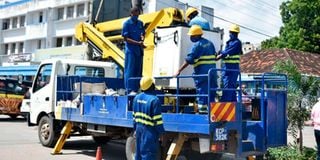Cash-strapped Kenya Power seeks lender to refinance it

Kenya Power technicians carry out repairs on an electricity line along Haile Selassie Road in Mombasa on December 5, 2020.
In 1973, the Government of Kenya signed a deal with the then East African Power and Lighting Company to connect electricity to rural areas.
Under that Rural Electrification Scheme (RES), the sole power distributor was to build new electricity lines in rural areas, construct substations, erect transformers and connect electricity to rural trading centres, factories and homes.
Four decades later, the Jubilee administration launched the Last-Mile Connectivity project, in a bid to connect all Kenyans to the national power grid.
As a result, the company’s successor, Kenya Power, has increased its high and medium voltage electricity network from 41,486 kilometres in 2013 to 84,681 kilometres in 2020. The monopoly also stepped up its transformer capacity from 6,490 megavolt amperes to 13,383 megavolt amperes over the same period.
Meanwhile, the number of customers who are now connected to the national grid has risen to 7.5 million from 1.2 million eight years ago.
Capital-intensive projects
But to pull off these capital-intensive projects, Kenya Power borrowed billions of shillings to finance the expansion in addition to donations. However, the projects yielded meagre returns to recoup the investment.
“The schemes of RES are generally referred to as sub-economic because their operational and maintenance costs exceed the revenues derived from them. This is because the activities are undertaken in the rural areas where income is low,” former Auditor-General Edward Ouko summed up the scheme in an audit report in 2018.
Financing these ambitious projects, coupled with mismanagement and operational inefficiencies at the company saw it develop more appetite for borrowing, which has eventually seen its debt balloon by more than 26 times in the last 15 years, totalling Sh109.9 billion in June 2020 from just Sh4.1 billion in 2004.
Of this, Sh56.6 billion is owed to commercial banks while Sh53.2 billion is on-lent debt guaranteed by the Kenyan government.
Three separate debts owed to Standard Chartered make up a majority of this commercial debt to a tune of Sh39.3 billion, while Rand Merchant Bank (Sh9.2 billion), Equity Bank (Sh4.9 billion) and Agence Francaise De Development (Sh1.2 billion) compound the list. However, the company settled a Sh2 billion Stanbic loan in September last year.
One of Standard Chartered Bank’s loans is due next month, with others in 2023 and 2026 while one of Rand Merchant bank’s loans is due in June and another one in 2025.
Meanwhile, Equity Bank’s loan is also due in 2025, while Agence Francaise De development’s debt has the longest repayment date and is due in 2030.
Core business
Yet, even as Kenya Power’s debt has ballooned over the past decade and a half, the revenue from its core business, which is selling electricity, rose by only six times from Sh20.3 billion in 2004 to Sh133.3 billion in 2020.
At the time, the company made a profit of Sh458 million.
However, the utility firm’s financial performance has quickly sunk to a Sh939 million loss for the year that ended June 2020.
To get a clear picture of how the loans are bleeding the country’s sole electricity distributor, Kenya Power has paid Sh33.9 billion in interest on its loans alone between 2012 and 2019. In 2012, the interest stood at Sh1.1 billion, rising to Sh1.3 billion in 2013 and Sh2.2 billion in 2014.
In 2015, the utility firm paid Sh4.6 billion in loan interests, Sh5.7 billion in 2016, Sh5.5 billion in 2017, Sh6.1 billion in 2018 and Sh7.1 billion in 2019.
Meanwhile, in the six months to December 2020, Kenya Power’s finance costs, which include the interest paid on the loans, bank overdrafts and penalties for late payment of invoices hit Sh8 billion, up from Sh3.8 billion in the six months to December 2019.
But in a late bid to dig itself out of the mounting debt hole, the firm on Wednesday floated an Expression of Interest (EOI) for refinancing of its Sh54.6 commercial debt after the government granted it a one-year renewable moratorium on the repayment of its Sh53.2 billion on-lent debt.
The company said that the projects it financed using its loans are long term and may take many years to realise returns hence the need to negotiate for longer repayment periods for the loans and seek better terms.
“The company expects to take advantage of the prevailing macro-economic situation to achieve lower interest rates compared to those under existing facilities consequently reducing its overall financing costs,” Kenya Power states in the EOI.
The company’s debt servicing has hit Sh20 billion annually, with 85 per cent of the debt unhedged on a long-term basis and denominated in US dollars and Euros yet its income is in Kenya shillings, exposing it to foreign exchange risks.
Bank debt
“The proceeds of some of the existing bank debt was utilized to finance specific long-term projects hence the need for a rationalisation at this time,” Kenya Power said in the EOI.
“Arising from the above, expressions of Interest are therefore being invited from eligible bidders to re-finance the existing term bank debt and convert the outstanding overdraft into a term loan, and to provide a facility to enable the reduction of trade payables,” the company said.
Interested banks and other financial institutions will score 30 marks if they readily have Sh58.8 billion, which is just over a third of the threshold required to take on Kenya Power’s debt, while financiers who have at least Sh32.1 billion will score 15 marks.
The Nation last month unsuccessfully attempted to reach Kenya Power to elaborately outline its plans to curb its runaway debt and state how it plans to realise returns from its huge investments to the expansion of the national power grid across the country.





